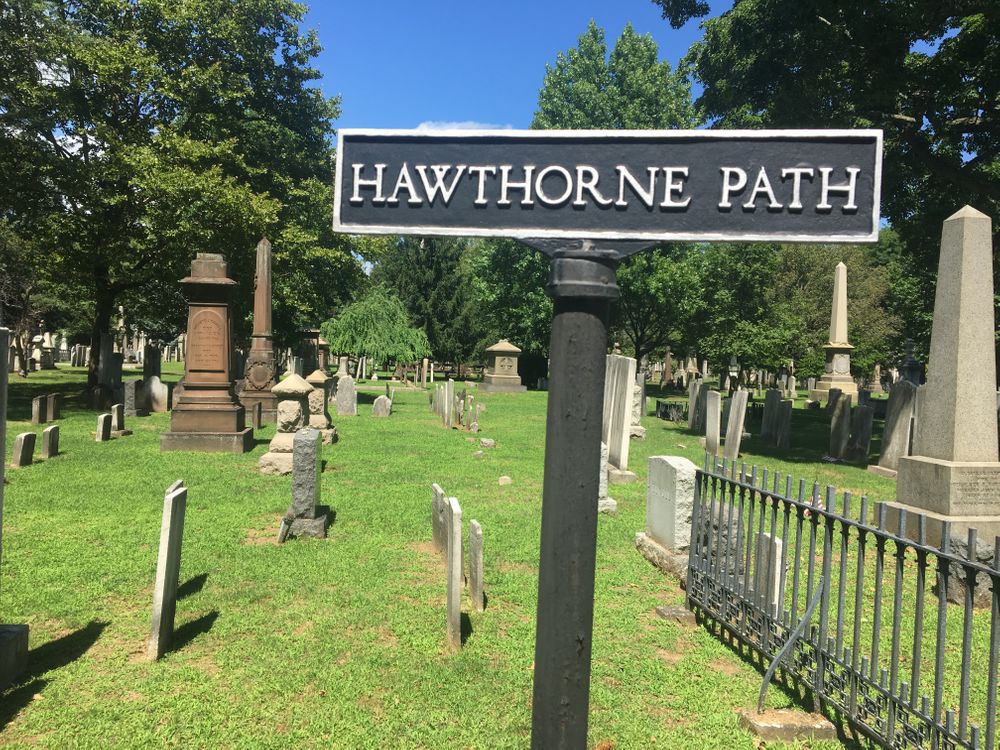
Grove Street Cemetery
227 Grove Street, New Haven, CT
The Grove Street Cemetery is the First Chartered Burial Ground in the United States. Built in 1796, the cemetery spans 18 acres on the east edge of the Dixwell neighborhood and abuts the Yale University campus. Its Egyptian Revivalist gate draws immediate attention from passersby, which bears the ominous inscription “The Dead Shall Be Raised.” The cemetery's gridded layout symbolically echoes the nine-square grid of the city found in downtown New Haven around the green and functionally organizes the graves of hundreds of notable figures, many of whom are affiliated with New Haven and Yale University.
Before it was a cemetery, the land was previously owned by the Fitch Family and tended as farmland.
The site that is now the Grove Street Cemetery was largely farmland owned by the Fitch Family, and utilized by Nathan Mansfield as well as the prominent Hillhouse family. It was designated a cemetery in 1797 with its first burial, when the New Haven Green (the city's initial burial site) became too crowded to accomodate further burials.
The Grove Street Cemetery found its place within the cultural landscape of New Haven in response to the Yellow Fever epidemic of 1794-95. Designed by Henry Austin and Hezekiah Augur to supplement the New Haven Green as a burial ground as a consequence of overcrowding due to the rampant spread of the disease, Senator Hillhouse galvanized groups of local prominent families to create a new burial ground on what was farmland. As the first cemetery in the United States designed with the intention of having designated family plots, social and status stratifications were undoubtedly reinforced through its utilization despite it being a communal space. Indeed, the Cemetery embodied a paradox of equality and exclusivity (an assortment of white abolitionists and influential African-Americans may be found buried there), but nevertheless was highly segregated— Yale alumni, people of color and poor people all confined to their respective corners within its 18 acres.
The Grove Street Cemetery was named a National Historical Landmark in 2000, noted by the United States Secretary of Interior for its Egyptian Revivalist gate symbolizing an architectural trend of romantic-classicism of the time. This choice was meant as a nod to antiquity— designed to immortalize the past echoed within traditional burial rituals of lots, graves, and markers serving to forever represent the dead. Though the block on which it sits is rather quiet and less traversed than the streets found on either side, York and Prospect, the relationship between the Cemetery and the outside community (mainly the Yale Campus) appears rather symbiotic. It is to be noted, however, that the college’s president Arthur Twining Hadley had commented upon the the inscription “The Dead Shall Be Raised” a quotation from Corinthians 15:52 saying “They certainly will be, if Yale needs the property,” perhaps gleaning insight on the relationship between the University and the surrounding areas through witticism.
The Grove Street Cemetery contrasts greatly with the bustling nature of New Haven; it is rather quiet here. Located just beyond the 9 original plots of the city, the contrast between the hustle and bustle of Downtown New Haven by the Green is highlighted by the tranquillity of the Cemetery.
The Grove Street Cemetery symbolizes the idyllic burial ground landscape envisioned by Sir Christopher Wren, its inventor. Between the pillars of the sandstone gate structure is a wrought iron fence which runs all the way across Grove and switches into a higher and thicker brownstone wall (aesthetically identical to the gate) on Ashmun and Prospect. Approximately every twenty feet, there is a larger ornamental line post structure which raises about two feet higher than the rest of the fence; at the top of this post stands a decorative bowl, sitting on a flat structure inscribed with the Winged Sun of Thebes, a symbol associated with royalty and power.
Shortly after entering the Cemetery one stumbles upon a small Victorian style red brick two-story chapel built in 1872. Just below the roof there is a gold butterfly, which, according to the pamphlets published by the Standing Committee of the New Haven City Burial ground, “symboliz[es] the flight of the soul.” The condition of this building is very good; the red bricks bright and clean. The maroon paneled doors, however, look quite aged, definitely purposefully not replaced in the last few decades; the left panel bearing the address of the Cemetery: 277 Grove Street. Though the chapel is no longer used to hold services, the Cemetery’s administrative and superintendent office can be found there.
The Grove Street Cemetery is divided into lanes each named for different trees, many of which can be found in the state of Connecticut. Some routes are less paved than others, however the plots are well kept. The gravestones vary in size, color, wear, height, material and level of extravagance. Many notable people are buried here, unsurprisingly often having more elaborate tombstones than the majority.
Researcher
Jordan Powell
Date Researched
Entry Created
N/A Date
Last Updated
July 14, 2025 at 10:03 PM EST by naomimain
Historic Name
Style
OtherCurrent Use
Private CemeteryEra
1638-1860Neighborhood
DixwellTours
Year Built
1796
Architect
Henry Austin and Hezekiah Augur
Current Tenant
N/A
Roof Types
Structural Conditions
Very Good
Street Visibilities
Yes
Threats
None knownExternal Conditions
Very Good
Dimensions
Street Visibilities
Yes
Owner
Private Group
Ownernishp Type
Client
James Hillhouse and the State of Connecticut
Historic Uses
Mixed Use










Comments
You are not logged in! Please log in to comment.